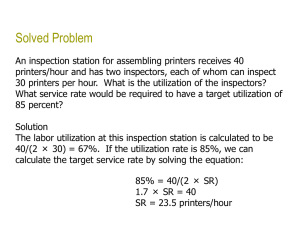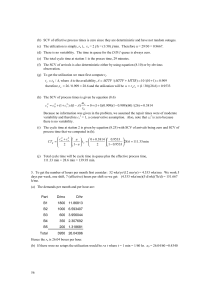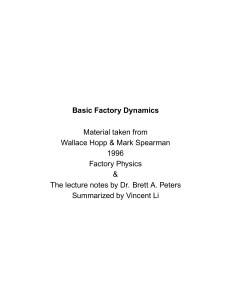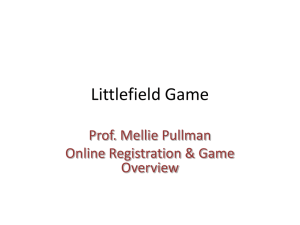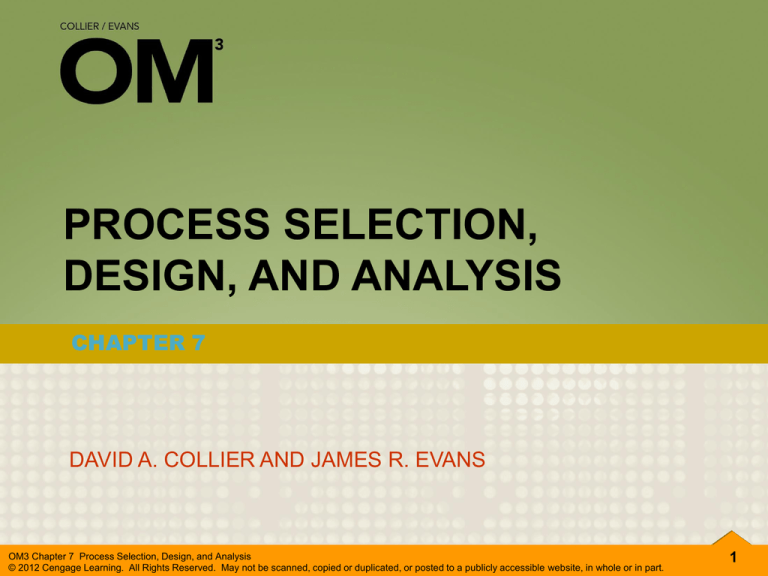
PROCESS SELECTION,
DESIGN, AND ANALYSIS
CHAPTER 7
DAVID A. COLLIER AND JAMES R. EVANS
OM3 Chapter 7 Process Selection, Design, and Analysis
© 2012 Cengage Learning. All Rights Reserved. May not be scanned, copied or duplicated, or posted to a publicly accessible website, in whole or in part.
1
Process Choice Decisions
Process design is an important operational
decision that affects the cost of operations,
customer service, and sustainability.
2
Process Choice Decisions – Types of Goods and
Services
• Custom, or make-to-order, goods and
services are generally produced and delivered as
one-of-a-kind or in small quantities, and are
designed to meet specific customers’
specifications.
Examples include ships, weddings, certain
jewelry, estate plans, buildings, and surgery.
3
Process Choice Decisions – Types of Goods and
Services
• Option, or assemble-to-order, goods and
services are configurations of standard parts,
subassemblies, or services that can be selected by
customers from a limited set.
Examples are Dell computers, Subway
sandwiches, machine tools, and travel agent
services.
4
Process Choice Decisions – Types of Goods and
Services
• Standard, or make-to-stock, goods and
services are made according to a fixed design,
and the customer has no options from which to
choose.
Examples are appliances, shoes, sporting
goods, credit cards, online Web-based
courses, and bus service.
5
Process Choice Decisions – Types of Processes
• Projects are large-scale, customized initiatives that
consist of many smaller tasks and activities that
must be coordinated and completed to finish on
time and within budget.
Characteristics: One-of-a-kind, large scale,
complex, resources brought to site; wide
variation in specs and tasks.
Examples: Legal defense preparation,
construction, customer jewelry, consulting, and
software development.
6
Process Choice Decisions – Types of Processes
• Job shop processes are organized around particular
types of general-purpose equipment that are flexible
and capable of customizing work for individual
customers.
Characteristics: Significant setup and/or changeover time, batching,
low to moderate volume, many routes, many different products, high
work-force skills, and customized to customer’s specs.
Examples: Many small manufacturing companies are set up as job
shops, as are hospitals, legal services, and some restaurants.
7
Process Choice Decisions – Types of Processes
• Flow shop processes are organized around a fixed
sequence of activities and process steps, such as
an assembly line, to produce a limited variety of
similar goods or services.
Characteristics: Little or no setup time, dedicated to small range of
goods or services that are similar, similar sequence of process steps,
moderate to high volume.
Examples: Assembly lines that produce automobiles and appliances,
production of insurance policies and checking account statements, and
hospital laboratory work.
8
Process Choice Decisions – Types of Processes
• A continuous flow process creates highly
standardized goods or services, usually around the
clock in very high volumes.
Characteristics: Very high volumes in a fixed
processing sequence, high investment in system,
24-hour/7-day continuous operation, automated,
dedicated to a small range of goods or services.
Examples: Chemical, gasoline, paint, toy, steel
factories; electronic funds transfer, credit card
authorizations, and automated car wash.
9
Process Choice Decisions
•
A product life cycle is a characterization of product
growth, maturity, and decline over time.
Four phases:
•
Introduction
Growth
Maturity
Decline and turnaround
A product’s life cycle has important implications in terms of process design
and choice. For example, new products with low sales volume might be
produced in a job shop process; however, as sales grow and volumes
increase, a flow shop process might be more efficient.
10
The Product-Process Matrix
• The product-process matrix is a model that
describes the alignment of process choice with
the characteristics of the manufactured good.
The most appropriate match between type of
product and type of process occurs along the
diagonal in the product-process matrix.
As one moves down the diagonal, the emphasis
on both product and process structure shifts from
low volume and high flexibility, to higher volumes
and more standardization.
11
Exhibit 7.1
Characteristics
of Different
Process Types
12
Exhibit 7.2
Product-Process Matrix
13
The Service-Positioning Matrix
•
•
In the product-process matrix, product volume, the
number of products, and the degree of
standardization/customization determine the
manufacturing process that should be used. This
relationship between volume and process is not found in
many service businesses.
The Service-Positioning Matrix is similar to the productprocess matrix in that it suggests that the nature of the
customer’s desired service encounter activity sequence
should lead to the most appropriate service system design
and that superior performance results by generally staying
along the diagonal of the matrix.
14
The Service-Positioning Matrix
• A pathway is a unique route through a service
system. Pathways can be customer- or
provider-driven, depending on the level of
control that the service firm wants to ensure.
• The service encounter activity sequence
consists of all the process steps and associated
service encounters necessary to complete a
service transaction and fulfill customer’s wants
and needs.
15
The Service-Positioning Matrix
• Customer-routed services are those that offer
customers broad freedom to select the
pathways that are best suited for their
immediate needs and wants, from many
possible pathways through the service delivery
system.
Examples include searching the Internet,
museums, health clubs, and amusement
parks.
16
The Service-Positioning Matrix
• Provider-routed services constrain customers to
follow a very small number of possible and
predefined pathways through the service system.
Examples are a newspaper dispenser and
logging on to a secure online bank account.
17
Exhibit 7.3
The Service
Positioning Matrix
Source: Adapted from D. A.
Collier and S. M. Meyer, “A
Service Positioning Matrix,”
International Journal of
Production and Operations
Management, 18, no. 12, 1998,
pp. 1123–1244. Also see D. A.
Collier and S. Meyer, “An
Empirical Comparison of Service
Matrices,” International Journal of
Operations and Production
Management, 2000 (no. 5–6), pp.
705–729.
18
Process Design – Four Levels of Work
• Task—a specific unit of work required to create
an output.
• Activity—a group of tasks (sometimes called a
workstation) needed to create and deliver an
intermediate or final output.
• Process—a group of activities.
• Value chain—a network of processes.
19
Exhibit 7.4 The Hierarchy of Work and Cascading Flowcharts for Antacid Tablets
20
Process and Value Stream Mapping
•
A process map (flowchart) describes the sequence of all
process activities and tasks necessary to create and
deliver a desired output or outcome.
•
Process maps document how work either is, or should be, accomplished,
and how the transformation process creates value.
A process boundary is the beginning or end of a process.
Makes it easier to obtain management support, assign process
ownership, and identify where performance measures should be taken.
21
Process and Value Stream Mapping
• In service applications, flowcharts generally
highlight the points of contact with the customer
and are often called service blueprints or service
maps.
• Such flowcharts often show the separation
between the back office and the front office with
a “line of customer visibility.”
22
Process and Value Stream Mapping
• The value stream refers to all value-added activities
involved in designing, producing, and delivering
goods and services to customers.
• A value stream map (VSM) shows the process flows
in a manner similar to an ordinary process map;
however, the difference lies in that value stream
maps highlight value-added versus non-value-added
activities and include costs associated with work
activities for both value- and non-value-added
activities.
23
Process and Value Stream Mapping
Examples of non-value-added activities include:
• Transferring materials between two nonadjacent
workstations
• Overproducing
• Waiting for service or work to do
• Not doing work correctly the first time
• Requiring multiple approvals for a low cost
electronic transaction
24
Exhibit 7.6 Restaurant Order Posting and Fulfillment Process
25
Process Design Methodology
1. Define the purpose and objectives of the process.
2. Create a detailed process or value stream map that
describes how the process is currently performed.
3. Evaluate alternative process designs.
4. Identify and define appropriate performance
measures for the process.
5. Select the appropriate equipment and technology.
6. Develop an implementation plan to introduce the
new or revised process design.
26
Process Mapping Improves Pharmacy Service
Metro Health Hospital in Grand Rapids, Michigan, applied
process mapping reducing the lead time for getting the first
dose of a medication to a patient in its pharmacy services
operations. The lead time was measured from the time an
order arrived at the pharmacy to its delivery on the
appropriate hospital floor. A process improvement team
carefully laid out all the process steps involved and found
that it had a 14-stage process with some unnecessary steps,
resulting in a total lead time of 166 minutes.
(continued)
27
Process Mapping Improves Pharmacy Service
During the evaluation process, the pharmacy calculated that
technicians were spending 77.4 percent of their time
locating products; when a pharmacist needed a technician
for clinical activities, the technician was usually off searching
for a drug. Overall, the pharmacy at Metro realized a 33percent reduction in time to get medications to patients,
and reduced the number of process steps from 14 to nine
simply by removing non-value-added steps. Patients have
experienced a 40-percent reduction in pharmacy-related
medication errors, and the severity of those errors has
decreased.
28
Process Analysis and Improvement
Strategies:
•
•
•
•
•
•
Increasing revenue by improving process efficiency in creating
goods and services and delivery of the customer benefit
package.
Increasing agility by improving flexibility and response to
changes in demand and customer expectations.
Increasing product and/or service quality by reducing defects,
mistakes, failures, or service upsets.
Decreasing costs through better technology or elimination of
non-value-added activities.
Decreasing process flow time by reducing waiting time or
speeding up movement through the process and value chain.
Decreasing the carbon footprint of the task, activity, process
and/or value chain.
29
Process Analysis and Improvement
Questions to ask for process analysis:
•
•
•
•
Are the steps in the process arranged in logical
sequence?
Do all steps add value? Can some steps be eliminated
and should others be added in order to improve quality or
operational performance? Can some be combined?
Should some be reordered?
Are capacities of each step in balance; that is, do
bottlenecks exist for which customers will incur excessive
waiting time?
What skills, equipment, and tools are required at each
step of the process? Should some steps be automated?
30
Process Analysis and Improvement
•
•
•
•
At which points in the system (sometimes called process
fail points) might errors occur that would result in
customer dissatisfaction, and how might these errors be
corrected?
At which point or points in the process should
performance be measured? What are appropriate
measures?
Where interaction with the customer occurs, what
procedures, behaviors, and guidelines should employees
follow that will present a positive image?
What is the impact of the process on sustainability? Can
we quantify the carbon footprint of the current process?
31
Process Analysis and Improvement
• Reengineering has been defined as “the
fundamental rethinking and radical redesign of
business processes to achieve dramatic
improvements in critical, contemporary measures
of performance, such as cost, quality, service,
and speed.”
32
Process Design and Resource Utilization
• Utilization is the fraction of time a workstation or
individual is busy over the long run.
Utilization (U) =
Resources Used
[7.1]
Resources Available
or
Utilization (U) =
Demand Rate
[Service Rate × Number
of Servers]
[7.2]
33
Solved Problem
An inspection station for assembling printers receives 40
printers/hour and has two inspectors, each of whom can inspect
30 printers per hour. What is the utilization of the inspectors?
What service rate would be required to have a target utilization of
85 percent?
Solution
The labor utilization at this inspection station is calculated to be
40/(2 × 30) = 67%. If the utilization rate is 85%, we can
calculate the target service rate by solving the equation:
85% = 40/(2 × SR)
1.7 × SR = 40
SR = 23.5 printers/hour
34
Process Design and Resource Utilization
• The average number of entities completed per unit time—
the output rate—from a process is called throughput.
–
•
Throughput might be measured as parts per day, transactions per
minute, or customers per hour, depending on the context.
A bottleneck is the work activity that effectively limits throughput of the
entire process.
–
Identifying and breaking process bottlenecks is an important part of
process design and improvement, and will increase the speed of the
process, reduce waiting and work-in-process inventory, and use
resources more efficiently.
35
Little’s Law
•
Flow time, or cycle time, is the average time it takes to
complete one cycle of a process.
•
Little’s Law is a simple formula that explains the
relationship among flow time (T ), throughput (R ), and
work-in-process (WIP ).
Work-In-Process = Throughput × Flow Time
or
WIP = R × T
[7.3]
•
If we know any two of the three variables, we can compute the third.
36
Solved Problem
Suppose that a voting facility processes an average of
50 people per hour and that, on average, it takes 10
minutes. What is the average number of voters in the
process? for each person to complete the v
Solution
WIP = R T
= 50 voters/hr (10 minutes/60 minutes per hour)
= 8.33 voters
37
Solved Problem
Suppose that the loan department of a bank takes an
average of 6 days (0.2 months) to process an
application and that an internal audit found that about
100 applications are in various stages of processing at
any one time. Using Little’s Law, we see that T = 0.2
and WIP = 100. What is the throughput? the v
Solution
R = WIP/T = 100 applications/0.2 months
= 500 applications per month
38
Solved Problem
Suppose that a restaurant makes 400 pizzas per week,
each of which uses one-half pound of dough, and that
it typically maintains an inventory of 70 pounds of
dough. In this case, R = 200 pounds per week of
dough and WIP = 70 pounds. What is the average flow
time?
Solution
T = WIP/R = 70/200
= 0.35 weeks, or about 21/2 days.
39

